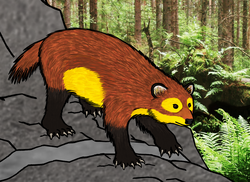Biology:Ursavini
From HandWiki
Short description: Extinct tribe of bears
| Ursavini | |
|---|---|

| |
| Life restoration of Ballusia orientalis | |
| Scientific classification | |
| Domain: | Eukaryota |
| Kingdom: | Animalia |
| Phylum: | Chordata |
| Class: | Mammalia |
| Order: | Carnivora |
| Family: | Ursidae |
| Subfamily: | †Ursavinae Hendey, 1980 |
| Tribe: | †Ursavini Hendey, 1980 |
| Genera | |
Ursavini is an extinct tribe of mammals of the family Ursidae (bears) endemic to North America, Europe, Africa, and Asia during Miocene through Pliocene, living from about 23—2.5 Mya, existing for roughly 20.5 million years.
Ursavini was assigned to the Ursinae by Hunt (1998) and Jin et al. (2007) and includes the genera Agriotherium and Ursavus.[1][2] However in a 2014 paper published on the origins of bears, found Agriotherium to be closer to extant bears and some species of Ursavus might warrant to be in a separate but related genus Ballusia.[3]
References
- ↑ Hunt, R. M. (1998). "Ursidae". in Jacobs, Louis; Janis, Christine M.; Scott, Kathleen L.. Evolution of Tertiary Mammals of North America: Volume 1, Terrestrial Carnivores, Ungulates, and Ungulate like Mammals. Cambridge, UK: Cambridge University Press. pp. 174–195. ISBN 0-521-35519-2.
- ↑ C. Jin, R. L. Ciochon, W. Dong, R. M. Hunt, Jr., J. Liu, M. Jaeger, and Q. Zhu. 2007. The first skull of the earliest giant panda. Proceedings of the National Academy of Sciences 104:10932-10937
- ↑ Qiu, Zhan-Xiang (2014). "A Late Miocene Ursavus skull from Guanghe, Gansu, China". Vertebrata PalAsiatica 52 (3): 265–302.
Wikidata ☰ Q7901157 entry
 |

